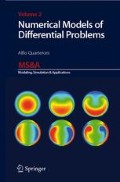Abstract
Navier-Stokes equations describe the motion of a fluid with constant density ρ in a domain Ω ⊂ ℝd (with d = 2, 3). They write as follows
u being the fluid velocity, p the pressure divided by the density (which will simply be called “pressure”), \( \nu = \tfrac{\mu } {\rho } \) the kinematic viscosity, µ the dynamic viscosity, and f a forcing term per unit mass that we suppose to belong to the space L2(ℝ+; [L2(Ω)]d) (see Sec. 5.2). The first equation is that of conservation of linear momentum, the second one that of conservation of mass, which is also called the continuity equation. The term (u ⋅ ∇)u describes the process of convective transport, while —div [υ(∇u + ∇uT)] the process of molecular diffusion. System (15.1) can be derived by the analogous system for compressible flows introduced in Chap. 14 by assuming ρ constant, using the continuity equation (that in the current assumption takes the simplified form divu = 0) to simplify the various terms, and finally dividing the equation by ρ. Note that in the incompressible case (15.2) the energy equation has disappeared. Indeed, even though such an equation can still be written for incompressible flows, its solution can be carried out independently once the velocity field is obtained from the solution of (15.1).
Preview
Unable to display preview. Download preview PDF.
Rights and permissions
Copyright information
© 2009 Springer-Verlag Italia, Milan
About this chapter
Cite this chapter
(2009). Navier-Stokes equations. In: Numerical Models for Differential Problems. MS&A, vol 2. Springer, Milano. https://doi.org/10.1007/978-88-470-1071-0_15
Download citation
DOI: https://doi.org/10.1007/978-88-470-1071-0_15
Publisher Name: Springer, Milano
Print ISBN: 978-88-470-1070-3
Online ISBN: 978-88-470-1071-0
eBook Packages: Mathematics and StatisticsMathematics and Statistics (R0)

